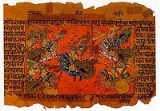
Mahabharata
Overview
The Mahabharata is one of the two major Sanskrit
Sanskrit literature
Literature in Sanskrit begins with the Vedas, and continues with the Sanskrit Epics of Iron Age India; the golden age of Classical Sanskrit literature dates to late Antiquity . Literary production saw a late bloom in the 11th century before declining after 1100 AD...
epic
Indian epic poetry
Indian epic poetry is the epic poetry written in the Indian subcontinent, traditionally called Kavya . The Ramayana and Mahabharata, originally composed in Sanskrit and translated thereafter into many other Indian languages, are some of the oldest surviving epic poems on earth and form part of...
s of ancient India
History of India
The history of India begins with evidence of human activity of Homo sapiens as long as 75,000 years ago, or with earlier hominids including Homo erectus from about 500,000 years ago. The Indus Valley Civilization, which spread and flourished in the northwestern part of the Indian subcontinent from...
and Nepal
Nepal
Nepal , officially the Federal Democratic Republic of Nepal, is a landlocked sovereign state located in South Asia. It is located in the Himalayas and bordered to the north by the People's Republic of China, and to the south, east, and west by the Republic of India...
, the other being the Ramayana
Ramayana
The Ramayana is an ancient Sanskrit epic. It is ascribed to the Hindu sage Valmiki and forms an important part of the Hindu canon , considered to be itihāsa. The Ramayana is one of the two great epics of India and Nepal, the other being the Mahabharata...
. The epic is part of itihasa
Indian epic poetry
Indian epic poetry is the epic poetry written in the Indian subcontinent, traditionally called Kavya . The Ramayana and Mahabharata, originally composed in Sanskrit and translated thereafter into many other Indian languages, are some of the oldest surviving epic poems on earth and form part of...
.
Besides its epic narrative of the Kurukshetra War
Kurukshetra war
According to the Indian epic poem Mahābhārata, a dynastic succession struggle between two groups of cousins of an Indo-Aryan kingdom called Kuru, the Kauravas and Pandavas, for the throne of Hastinapura resulted in the Kurukshetra War in which a number of ancient kingdoms participated as allies of...
and the fates of the Kaurava
Kaurava
The term Kaurava is a Sanskrit term, that means the descendants of Kuru, a legendary king who is the ancestor of many of the characters of the Mahābhārata.The term is used in the Mahābhārata with two meanings:...
s and the Pandava
Pandava
In the Hindu epic Mahābhārata, the Pandava are the five acknowledged sons of Pandu , by his two wives Kunti and Madri. Their names are Yudhisthira, Bhima, Arjuna, Nakula and Sahadeva. Although, Karna is told by Lord Krishna that according to the laws and ethics he is the first son of Kunti making...
s, the Mahabharata contains much philosophical
Hindu philosophy
Hindu philosophy is divided into six schools of thought, or , which accept the Vedas as supreme revealed scriptures. Three other schools do not accept the Vedas as authoritative...
and devotional material, such as a discussion of the four "goals of life" or purusharthas
Purusharthas
In Hinduism, refers to a goal, end or aim of human existence...
(12.161). The latter are enumerated as dharma
Dharma
Dharma means Law or Natural Law and is a concept of central importance in Indian philosophy and religion. In the context of Hinduism, it refers to one's personal obligations, calling and duties, and a Hindu's dharma is affected by the person's age, caste, class, occupation, and gender...
(right action), artha
Artha
Artha is a Sanskrit term meaning "purpose, cause, motive, meaning, notion".It refers to the idea of material prosperity. In Hinduism, artha is one of the four goals of life, known as purusharthas. It is considered to be a noble goal as long as it follows the dictates of Vedic morality...
(purpose), kama (pleasure), and moksha
Moksha
Within Indian religions, moksha or mukti , literally "release" , is the liberation from samsara and the concomitant suffering involved in being subject to the cycle of repeated death and reincarnation or rebirth.-Origins:It is highly probable that the concept of moksha was first developed in...
(liberation).
Among the principal works and stories that are a part of the Mahabharata are the Bhagavad Gita
Bhagavad Gita
The ' , also more simply known as Gita, is a 700-verse Hindu scripture that is part of the ancient Sanskrit epic, the Mahabharata, but is frequently treated as a freestanding text, and in particular, as an Upanishad in its own right, one of the several books that constitute general Vedic tradition...
, the story of Damayanti
Damayanti
Damayanti , a character in Hindu mythology, was the princess of Vidarbha Kingdom, who married king Nala, of Nishadha Kingdom, and their story is told in the Mahabharata.-The story:...
, an abbreviated version of the Ramayana, and the Rishyasringa
Rishyasringa
Rishyasringa or ' was a boy born with the horns of a deer in Hindu-Buddhist mythology, who became a seer and was seduced by a King's daughter, which had various results according to the variations in the story.-Hindu versions of the...
, often considered as works in their own right.
Traditionally, the authorship of the Mahabharata is attributed to Vyasa
Vyasa
Vyasa is a central and revered figure in most Hindu traditions. He is also sometimes called Veda Vyasa , or Krishna Dvaipayana...
.
Unanswered Questions
Discussions

